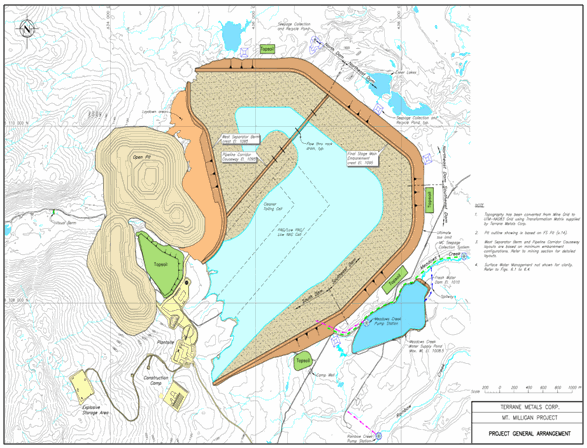Mt. Milligan Project
Terrane Metal Corp’s Mt. Milligan Project
Integrating ARD Management into Mine Design
Project
Terrane’s Mt. Milligan copper-gold project is located 155 km northwest of Prince George, BC, Canada and involves a large scale open pit mine and associated 60,000 tpd processing plant. About 250 Mt of overburden and waste rock will be mined from the open pit and 330 Mt of tailing produced from the mill.
ARD Prediction
The Mt. Milligan project benefits from almost 20 years of ARD prediction work which includes:
- Mineralogical studies of fresh and weathered rock
- over 1800 ABA assays
- over 5000 ICP-MS multi-element scans
- 59 shake flask extractions
- 56 Net Acid Generation tests (NAG tests)
- 23 tailing solutions assays from metallurgical studies
- 7 column tests
- 16 humidity cell tests including one test that ran for 9.5 years
The overall assessment of the potential for ARD from waste rock is based on goestatistics. Separate sulphur and NP estimates were prepared and then combined into a NPR block model. The estimation of sulphur and neutralizing potential was estimated in multiple passes, using ordinary kriging as the primary estimation methodology, and inverse distance squared to fill in small gaps not estimated in kriging passes.
The estimation of sulphur was conducted using a database containing both LECO S and ICP S. The estimation of NP was conducted using multiple ordinary kriging passes. For the first pass only assayed NP data was used. For the second pass, both NP and calculated NP from Ca assays (as a surrogate) were utilized to make estimates. Final NP values were established from both primary and secondary estimates. If no estimate was made in the first pass, NP was set to the second pass estimate, incorporating calculated NP. If estimates were made in both cases, assayed NP estimates were given priority. In the case where the average distance to composites used to make an estimate in the first pass was lower than in the second pass, then NP was set to the first pass estimate. Otherwise, NP was calculated as a combination of both estimates, with the weighting derived from the ratio of average distances used. This procedure maximized the use of data while placing greater weight on the more accurate NP assays from ABA. Results for one bench are shown in the Figure to the right.
The overall findings of the ARD prediction and assessment work are summarized below:
- Two types of tailing will be produced: a larger volume, low sulphur (NAG) scavenger tailing and a smaller volume, high sulphur (PAG) cleaner tailing
- About 37% of the waste rock (25% of the total waste including overburden) has a NPR < 1
- PAG and NAG waste rock blocks cluster which makes segregation during mining simpler
- Acidic drainage has not been produced from laboratory testing of waste rock. A high sulphur/low carbonate (NPR = 0.5) humidity cell test run for 9.5 years but did not produce ARD.
- NAG test results are consistent with ABA
- Humidity cells and sequential NAG testing indicates a NPR cutoff between 1 and 2. Nevertheless a conservative NPR segregation criteria of 2 was chosen for mine operations.
- Oxide/weathered waste rock may be somewhat higher metal leaching compared to non-oxidized waste rock
ARD Management
Prevention of ARD formation at Mt. Milligan will be based on the following principles:
- Segregate and submerge PAG waste rock/cleaner tailing in the tailing storage facility (TSF)
- Segregate and submerge oxide/weathered waste rock in the TSF
- Use NAG waste rock and overburden for construction including the TSF dams
- Place a scavenger tailing as a cover over potentially acid generating tailing and waste rock during the last 8 months mill operations.
The general arrangement of the mine is shown in the Figure at right. Management of ARD will be accomplished during operations by:
- testing blast hole samples for ABA to verify and further develop the ARD block model
- implementing the segregation plan using geological and engineering controls and a GPS controlled computerized dispatch system
- maintaining and checking mining records to ensure that the management plan is followed as planned
Lessons Learned
To be successful, ARD prediction and management plans should be fully integrated into mining and mineral processing operational plans. Mining, milling, geology and environmental staff should work closely during mine design and feasibility assessments to develop optimum solutions for ARD management.

